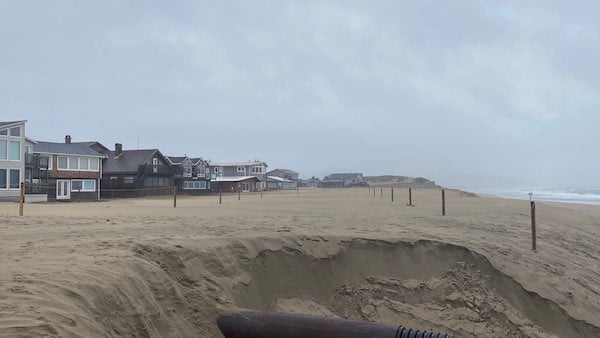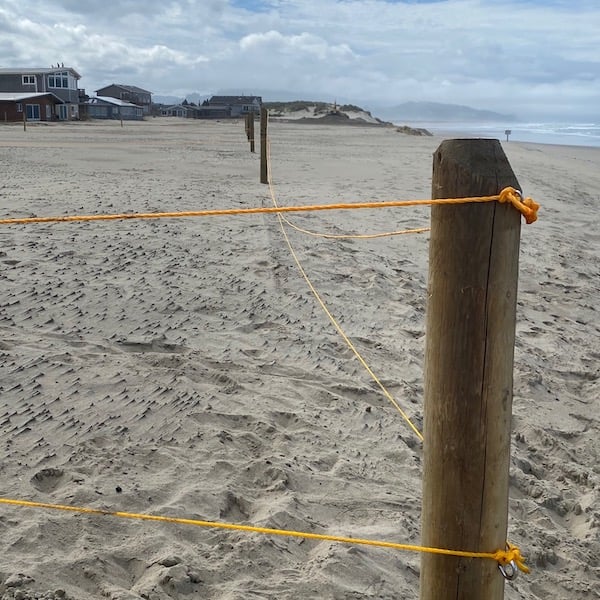
About a week ago we received complaints from beachgoers and our local membership in Pacific City about "fencing" along the ocean shore. There was no signage or explanation as to the intention of the newly placed posts that were linked with rope around a little over an acre of the ocean shoreline in Pacific City. Posts and ropes on beaches provoke a bit of a reaction out of Oregonians that are just wired to defend their beach birthright. As the complaints grew we investigated with the appropriate authorities - Oregon Parks and Recreation Department (OPRD) and Tillamook County. We were able to determine that there had recently been an OPRD permit issued for some sand management activities, but there was nothing in there about fencing off portions of the ocean shore, nor was it a permitted action of County's beach and dune overlay zone ordinance. Upon inquiring with OPRD about contact with the homeowners, we learned that they had reached out to the homeowner in charge of the project for the continuous lots and were immediately deferred to their lawyer. All things pointed to a property rights challenge of the public easement that is the Beach Bill, and Surfrider Foundation, in response to local concerns, posted the photos and issue to our social media accounts.
In about an hour the photos of the roped off beach backed by Haystack Rock had attracted a lot of engagement and emotion on our Facebook page, as social media engagement often does. It also attracted at least one of the property owners, who we immediately requested the opportunity for dialogue on the phone. In the meantime, we learned from OPRD that they had made contact with the consultant in charge of the sand management project for the group of homeowners and that 4 of the 5 property owners agreed to remove the posts and ropes, unaware it was not permitted. It was clear from some of the social media back and forth that not all of the property owners had the same intentions, so we wanted to follow up with one of the owners where we had an opportunity for dialogue. While we still had the one property moving forward with what looks like a separate legal challenge of the public easement (stay tuned), we decided to speak with one of the owners that had placed (and subsequently removed) the fencing for a completely different reason that had nothing to do with a legal access or an easement challenge.
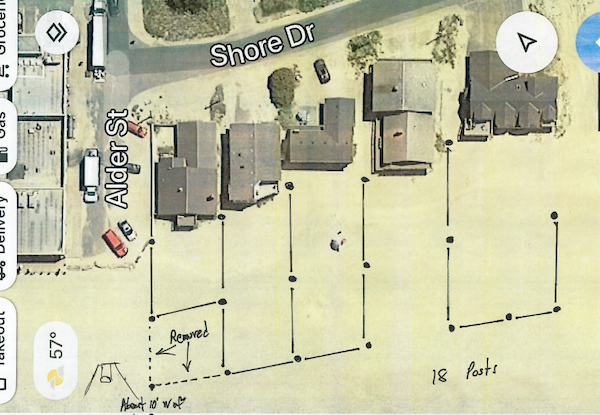
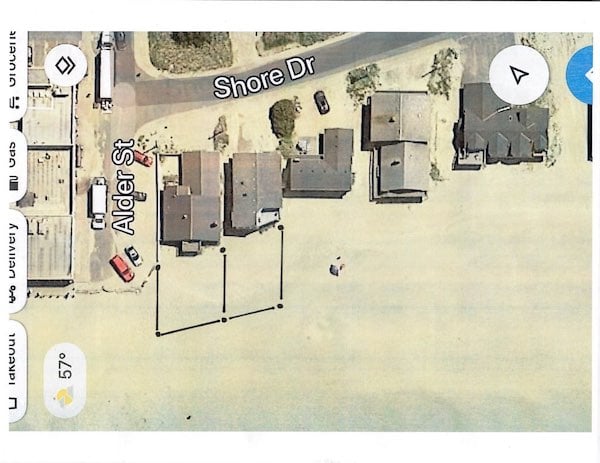 General location of the fencing before and after it's removal as sketched by a local Pacific City resident
General location of the fencing before and after it's removal as sketched by a local Pacific City resident
So we had a chat with one of the property owners who we'll call Frank (I have not asked permission to use his name). Frank was understandably very frustrated with us when I called him. Our Facebook post had drawn the ire of Oregonians out to hate someone for threatening their beach birthright and that someone (at least one of them) felt like him and his family. Frank wanted to defend that they were caught in the crossfire and did not intend to challenge public beach access. I listened. Frank explained they had put the fencing up to protect some dune plantings they are required to plant - which didn't actually occur based on seasonal recommendations from the state - more on that here. We both have a lot of opinions about dune management, many in common with respect to it’s futile effort and expense. The plants are required following dune grading and sand management projects where vast amounts of sand on the ocean shore are bulldozed off of dunes or pushed off of people's homes, roads and utilities. Many beachfront homeowners are faced with sand inundation and management practices such as this, a cost of living or having a vacation home on the ocean shore.
Frank explained how he and his siblings had inherited the house, and while we agreed philosophically that living on the ocean shore was just a bad idea, the house is there, and his family still loved it. But the problem remained, how to live on the dynamic ocean shoreline, under such extreme management conditions ranging from sand inundation to erosion and armoring. Moreover in Oregon, that ever-changing stretch of property moves in and out of the public recreational easement, blurring the lines between someone's backyard and the public beach. Add to that some broader challenges with increased tourism - the sleepy little beach town that the family vacation home resided in now more resembles Orange County than Tillamook during summer and holidays. From a sand and beach management perspective, it has become as much a cost to their patience as it has to their pocket book.
Many homes like these along the ocean shore in Oregon were developed prior to Statewide Planning Goal 18, and the management challenges they face today really underscore the importance of that planning goal in guiding responsible development along the ocean shore. Many developments prior to the guidance of Goal 18 also have property lines that extend down onto the dry sandy beach that the public enjoys as part of the Beach Bill's recreational easement. Many of these homes face sand erosion issues one year and a decade later they are shoveling sand out of their living room from being inundated by too much of it. Generally speaking, these homes find themselves often in a no-win situation - it's either retreat or it's a constant sand and erosion management situation costing the homeowner thousands of dollars to engage in projects that generally just don't work. And, in a place like Pacific City where the public is highly active recreating the beach, private property and public recreation can sometimes clash.
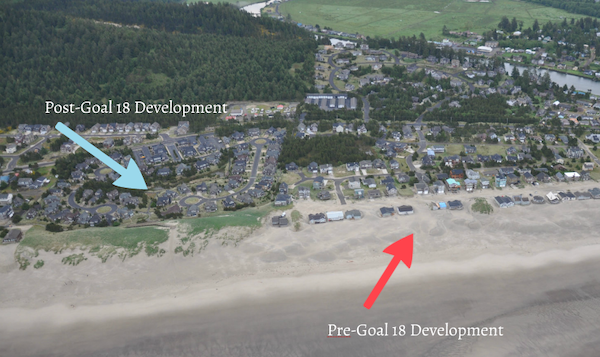 The influence of Goal 18 in guiding responsible development is eloquently demonstrated by an aerial view of Pacific City. Photos: Department of Land Conservation and Development
The influence of Goal 18 in guiding responsible development is eloquently demonstrated by an aerial view of Pacific City. Photos: Department of Land Conservation and Development
Climate change is already exacerbating these challenges along our coastline. At the south end of Pacific City, you can see in the below photo a stark example of how shifting El Nino patterns, prevailing winds and increased storm activity can further these extreme coastal management challenges. The photo at left is from the late 70s and the photo at right is a few years later in the early 80s. One year's increased storm activity can lead to shoreline armoring with rip rap to protect homes from the ocean, while the next year those same homes might be bulldozing sand off the house. The narrow margin of our public beaches will continue to get squeezed from both directions and these private and public property rights will be continually challenged.
While today we can sit and have the hindsight that Goal 18 can provide us today, the fact remains that some of these homes that existed prior are still there now. They have only imperfect management solutions and they come at cost to both the homeowner and the public. While we don't think we're out of the woods with the legal challenge for the one individual's property where some of the fence remains, at the heart of these other properties is a Foredune Management Plan that needs to be readdressed with local residents and homeowners. In the past, we have found it very challenging to organize beachfront homeowners in Pacific City since few of them are local full-time residents. We may philosophically disagree on whether and how we develop and live on the ocean shoreline, but Surfrider Foundation is more than willing to sit down with homeowners and local planners, roll up our sleeves and come up with responsible long term management decisions that we can all live with and that protect our shared interest in Oregon's beaches. Climate change, development, tourism and beach recreation will all create increased challenges and stressors on this unincorporated community like many other coastal towns in the US. The question is what will we do about it?


